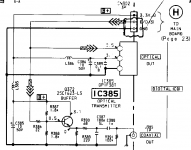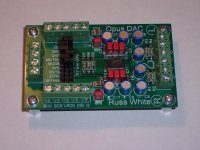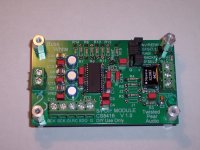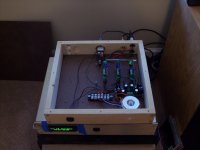promitheus said:Thanks, this would be interested to see.
I think that the voltage level of the TOSLINK input is too low.
the schematic shows 1,4V only. How much should the Coax S/PDIF be? 5V?
Here is the info from the CS8416 DS:
Differential Input Sensitivity, RXP[7:0] to RXN VTH - 150 200 mVpp
So 1.4V is certainly plenty. 🙂
You should be able to use what you have just fine. 🙂
Cheers!
Russ
Also normal S/PDIF voltage is 0.5 to 1 V, but the additonal .4V will not hurt anything according to CS8416 DS. 🙂
So you should be in great shape.
Cheers!
Russ
So you should be in great shape.
Cheers!
Russ
I found a solution.
I read about the Elektor magazine tos to coax SPDIF converter and I can buy the Pcbs.
take a look at the attachement.
I will connect the data that goes to the Toslink transmitter inside the CD player to the pin1 IC2a see schematic.
If anybody wants the pdf file in english I can´t post it here so please contact me with email.
I read about the Elektor magazine tos to coax SPDIF converter and I can buy the Pcbs.
take a look at the attachement.
I will connect the data that goes to the Toslink transmitter inside the CD player to the pin1 IC2a see schematic.
If anybody wants the pdf file in english I can´t post it here so please contact me with email.
Attachments
promitheus said:I found a solution.
I read about the Elektor magazine tos to coax SPDIF converter and I can buy the Pcbs.
I am sure that would work fine, but in your case it should be simple enough to take the S/PDIF straight from your CDP.
Cheers!
Russ
Hey cool!
thanks for the time you took to scan that.
It looks like an easy idea to use because I can use voltage supply and data directly from Toslink.
thanks for the time you took to scan that.
It looks like an easy idea to use because I can use voltage supply and data directly from Toslink.
First Opus is playing music... 🙂
Just wanted to let you folks know that the Opus is alive and well. Some pictures of the stuffed DAC and Receiver PCBs. 🙂
Its been a long time coming, but I believe it was worth the wait.
USB PCB and BA;/SE converter coming very soon now.
BTW, DipTrace rocks! Glad I switched from Eagle.

Cheers!
Russ
Just wanted to let you folks know that the Opus is alive and well. Some pictures of the stuffed DAC and Receiver PCBs. 🙂
Its been a long time coming, but I believe it was worth the wait.

USB PCB and BA;/SE converter coming very soon now.
BTW, DipTrace rocks! Glad I switched from Eagle.

Cheers!
Russ
Attachments
Hey the look absolutely wonderful!
Nice job! 😉
BrianDonegan : thanks for the schematic of the coax output. I will use that.
Nice job! 😉
BrianDonegan : thanks for the schematic of the coax output. I will use that.
Re: First Opus is playing music... 🙂
Very nice work indeed, Russ. I might have to get a set of the new boards despite alredady having the proto's.
I agree with your opinion of DipTrace. I bought the DIY'er licence and haven't looked back.
Russ White said:Just wanted to let you folks know that the Opus is alive and well. Some pictures of the stuffed DAC and Receiver PCBs. 🙂
Its been a long time coming, but I believe it was worth the wait.
USB PCB and BA;/SE converter coming very soon now.
BTW, DipTrace rocks! Glad I switched from Eagle.
Very nice work indeed, Russ. I might have to get a set of the new boards despite alredady having the proto's.
I agree with your opinion of DipTrace. I bought the DIY'er licence and haven't looked back.
Re: Re: First Opus is playing music... 🙂
Thanks guys!
I learned a lot from the beta.
I owe a lot to many of the forum members who gave me good advice and showed me where to find answers when I needed them.
I will be testing with two DAC boards tonight in dual differential mode (mono). That is supposed to get us another -3db SNR. like -117db was not low enough. 🙂
Cheers!
Russ
promitheus said:Hey the look absolutely wonderful!
Nice job! 😉
metalman said:
Very nice work indeed, Russ. I might have to get a set of the new boards despite alredady having the proto's.
Thanks guys!
I learned a lot from the beta.
I owe a lot to many of the forum members who gave me good advice and showed me where to find answers when I needed them.
I will be testing with two DAC boards tonight in dual differential mode (mono). That is supposed to get us another -3db SNR. like -117db was not low enough. 🙂
Cheers!
Russ
Russ-
Been watching the tread- excellent work! I can't wait till the usb board comes out! A bit skeptic about being computer powered
Once it's out I'll be buying a set!
Thx for the great work!
Been watching the tread- excellent work! I can't wait till the usb board comes out! A bit skeptic about being computer powered

Once it's out I'll be buying a set!
Thx for the great work!
A bit skeptic about being computer powered
i suppose only the usb audio to i2c conversion on the extender board is usb-bus powered, that shouldn't be too awful for the rest of the dac.
A bit skeptic about being computer powered
If the USB spec has 2 of its wires just for power (is this true?)
then it might be a simple matter to fix?:
Don't connect the 2 USB power wires to the circuit board from the USB plug that goes to the computer. Then you could attach wires from a battery pack or your own power supply to these terminals on the board?
If this is true, the instructions should point out which wires not to connect, and voltage required from the power supply. Can one use the same power supply as used for the DAC?
USB Bus or Self Powered
Hey guys,
Sorry for the delay in writing this, but after discussing this with Brian and a few other friends I have decided that it would be rather easy to design the USB module so that it can be use self powered or bus powered on the same PCB.
Using the digital (I2S) output I don't think this will make much difference at all (if any), but for those who might want to use the analog outputs of the USB module this will raise the performance quite a lot. Self powered this USB DAC module will easily outperform any NOS TDA15xx based DAC in terms of SNR and distortion. So even standalone a self powered USB DAC module should be quite good if you use suitable drivers etc...
For even better performance you can just take the I2S out from the USB module and feed an Opus DAC. Then you also have the benefits of balanced outputs.
FWIW I am also working on an Ethernet based module, but that me be a while in coming.
Cheers!
Russ
Hey guys,
Sorry for the delay in writing this, but after discussing this with Brian and a few other friends I have decided that it would be rather easy to design the USB module so that it can be use self powered or bus powered on the same PCB.
Using the digital (I2S) output I don't think this will make much difference at all (if any), but for those who might want to use the analog outputs of the USB module this will raise the performance quite a lot. Self powered this USB DAC module will easily outperform any NOS TDA15xx based DAC in terms of SNR and distortion. So even standalone a self powered USB DAC module should be quite good if you use suitable drivers etc...
For even better performance you can just take the I2S out from the USB module and feed an Opus DAC. Then you also have the benefits of balanced outputs.
FWIW I am also working on an Ethernet based module, but that me be a while in coming.
Cheers!
Russ
FWIW I am also working on an Ethernet based module, but that me be a while in coming.
Man, I thought *I* was bad at keeping secrets... 😉
BrianDonegan said:
Man, I thought *I* was bad at keeping secrets... 😉
Brian, how did you guys go about creating that google map with the locations of people who bought your stuff? It's really cool. Is that what they call a "mashup"?
ezkcdude said:
Brian, how did you guys go about creating that google map with the locations of people who bought your stuff? It's really cool. Is that what they call a "mashup"?
Ah, nevermind. I just looked at the page source, and it looks like your using the Google API. I think I can figure it out now.
- Home
- More Vendors...
- Twisted Pear
- Mr White's "Opus", designing a simple balanced DAC



